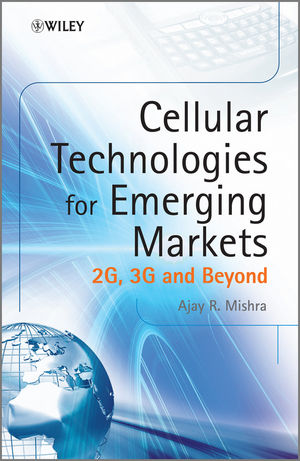Cellular Technologies for Emerging Markets: 2G, 3G and BeyondISBN: 978-0-470-77947-7
Hardcover
326 pages
July 2010
 Other Available Formats: E-book
|
||||||
Foreword 2: Connecting the Unconnected.
Preface.
Acknowledgements.
1 Cellular Technology in Emerging Markets.
1.1 Introduction.
1.2 ICT in Emerging Markets.
1.3 Cellular Technologies.
1.4 Overview of Some Key Technologies.
1.5 Future Direction.
2 GSM and EGPRS.
2.1 Introduction.
2.2 GSM Technology.
2.3 Network Planning in the GSM Network.
2.4 EGPRS Technology.
2.5 EGPRS Network Design and Optimization.
3 UMTS.
3.1 The 3G Evolution – UMTS.
3.2 UMTS Services and Applications.
3.3 UMTS Bearer Service QoS Parameters.
3.4 QoS Classes.
3.5 WCDMA Concepts.
3.6 ATM.
3.7 Protocol Stack.
3.8 WCDMA Network Architecture – Radio and Core.
3.9 Network Planning in 3G.
3.10 Network Optimization.
4 CDMA.
4.1 Introduction to CDMA.
4.2 CDMA: Code Division Multiple Access.
4.3 Spread Spectrum Technique.
4.4 Codes in CDMA System.
4.5 Link Structure.
4.6 Radio Resource Management.
4.7 Planning a CDMA Network.
4.8 CDMA2000.
4.9 TD-SCDMA.
5 HSPA and LTE.
5.1 HSPA (High Speed Packet Access).
5.2 HSDPA Technology.
5.3 HSDPA Channels.
5.4 Dimensioning in HSDPA.
5.5 Radio Resource Management in HSDPA.
5.6 High Speed Uplink Packet Access (HSUPA).
5.7 HSUPA Channels.
5.8 HSUPA Radio Resource Management.
5.9 HSPA Network Dimensioning.
5.10 LTE (Long Term Evolution).
5.11 LTE Technology.
5.12 Radio Resource Management.
5.13 Security in LTE.
6 OFDM and All-IP.
6.1 Introduction to OFDM.
6.2 OFDM Principles.
6.3 MIMO Technology.
6.4 OFDM System.
6.5 Design of OFDM Channel.
6.6 Multi-User OFDM Environment.
6.7 All-IP Networks.
6.8 Architecture of All-IP Networks.
7 Broadband Wireless Access: WLAN, Wi-Fi and WiMAX.
7.1 Wireless Technology Differentiation.
7.2 Wireless LAN.
7.3 Wi-Fi Networks.
7.4 WiMAX Networks.
8 Convergence and IP Multimedia Sub-System.
8.1 Introduction to Convergence.
8.2 Key Aspects of Convergent Systems.
8.3 Architecture in Convergent Networks.
8.4 IMS.
8.5 IMS Architecture.
8.6 IMS Security System.
8.7 IMS Charging.
8.8 Service Provisioning in IMS.
9 Unlicensed Mobile Access.
9.1 Introduction to UMA.
9.2 Working on UMA Network.
9.3 Architecture of UMA.
9.4 Up Interface in UMA.
9.5 Protocols in UMA.
9.6 Security Mechanism of UMA.
9.7 Identifiers and Cell Identifiers in UMA.
9.8 Mode and PLMN Selection.
9.9 UMAN Discovery and Registration Procedures.
9.10 UNC Blocks.
9.11 Comparison between Femtocells and UMA.
9.12 Conclusion.
10 DVB-H.
10.1 Mobile Television.
10.2 Introduction to DVB.
10.3 DVB-H Ecosystem.
10.4 DVB-H System Technology.
10.5 DVB-H Network Architecture.
10.6 DVB-H Network Topologies.
10.7 Network Design in the DVB-H Network.
Appendix A VAS Applications.
A.1 Multimedia Messaging Service.
A.2 Push-to-Talk over Cellular.
A.3 Streaming Service.
A.4 Short Message Service.
A.5 Wireless Application Protocol.
Appendix B Energy in Telecommunications.
B.1 The Solution Exists – But It’s Not Very Good.
B.2 Renewable Energy – a Better Solution.
B.3 The Optimal Design for a Base Station Site.
B.4 Business Case for Renewable Energy in Mobile Base Station Sites.
B.5 Effects of Climate Change on Mobile Networks.
Bibliography.
Index.



